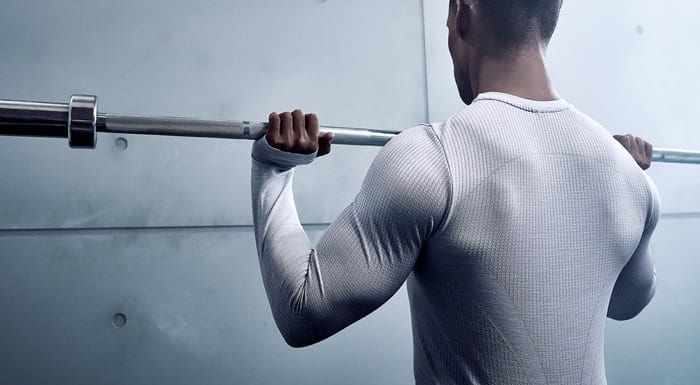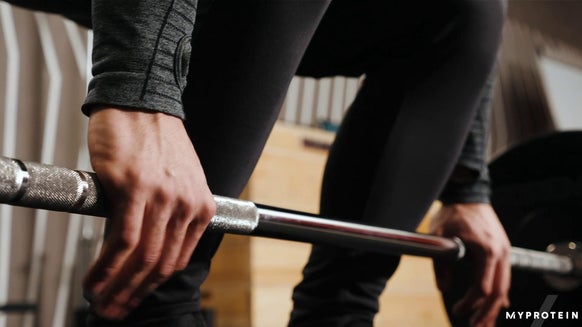Master the Incline Bench Press | Technique & Variations

Whilst the upper chest can be targeted via compound movements (incline dumbbell bench press, smith machine bench press, barbell guillotine press, incline press-ups) and isolation movements (incline cable fly, incline dumbbell fly, incline dumbbell pullovers); one of the common exercises that are applied when looking to develop the upper chest, is the incline barbell bench press.
As well as developing the upper chest, the incline bench press is unique in the sense that it typically prevents any ‘pecking’, otherwise known as lifting your head and neck during the bench press.
Below is a step-by-step guide on how to perform the incline barbell bench press and some common mistakes that you may encounter when performing the exercise.
Incline Bench Press Technique
- Firmly position your feet flat on the ground and lie completely flat on the incline bench.
- Ensure that your shoulder blades (scapula) is completely retracted against the bench.
- With a medium-width grip (about shoulder width), carefully un-rack the barbell until it is held above just chest height. At this stage, your arms should be completely extended.
- As you lower the bar down to your chest, take a deep breath and completely inhale.
- Throughout this part of the movement, the barbell should be lowered cautiously and constantly under tension.
- As you touch the chest, make sure that you do not bounce the barbell off your chest as this will take away the stimulated tension and instead increase the likelihood of injury.
- Once the bar has gently touched your chest, use an elbow extension to drive the barbell back to the starting position.
- Repeat this movement for the designated number of repetitions.
Incline Bench Press Common Mistakes
Arching your back
Whilst back arching is not usually permitted in the traditional bench press, it is slightly accepted in the flat bench due to the powerlifting influence. The incline bench press however, bears no relevance at all and those doing this need to re-evaluate their technique and form. Whilst arching your back can generally allow you to shift more resistance, it also alters the angle of the movement; so much so that it may as well be a flat bench press once again.
Furthermore, your back is put at great risk throughout this alternative position. In order to prevent this, keep your back flat on the bench regardless of how much weight you are trying to lift and remember; your form and technique is far more important than the number lifted in terms of longevity.
Bouncing the bar
Bouncing the bar is something that is performed in any bench press variation, due to the fact that the momentum generated makes the resistance lifted easier. This may put your sternum at great risk of injury and will also take away the stimulated tension on the chest throughout the movement.
Not using a spotter
Using a spotter will primarily improve the safety of any free weight movement due to the fact that there is a person supervising and is on hand in case the lifter is at risk at any moment. It must be noted that the spotting technique must be correct and moreover, the spotter should know when is the correct time to spot. The use of a spotter can also be beneficial both physically and psychologically.
Physically, a spotter has been shown to be excessively beneficial in terms of being able to increase lifting loads and therefore leading to increased strength and hypertrophy. Psychologically, due to the enhanced perceived safety and encouragement, the lifter feels that they are able to perform the repetitions confidently and effectively.
Not pausing at the bottom
Pausing at the bottom of a pressing moment will not only allow you to gain composure for the concentric phase of the movement, but it will also allow you to add increased tension and strain (beneficial strain) across the muscle fibres leading to an increased likelihood of muscular hypertrophy.
Next time you perform the incline bench press, lower the barbell for 2/3 seconds, pause at the bottom for 1/2 seconds before explosively lifting the barbell back to the starting position.
Not using your legs
Driving through your heels, transcending to your legs will not only create a firm base for your bench press, but it will also lead to increased resistance lifted.
The leg drive that is performed will result in extra power at the bottom phase of the bench press, this increase in power will mean that you will be able to press more weight.
In order to make sure that this leg drive is successful and performed correctly, try the following 4 methods:
Make sure the positioning of your feet is correct at the beginning of the movement Set correct and efficient timing cues Train your legs so you have a strong drive Progressively overload
Incline Bench Press Benefits
Muscle Isolation:
Increasing the incline will place more focus on the upper chest allowing for a more isolated move. This can benefit someone who needs to improvie size or strength in that particular part of the chest.
Additional Muscles Worked:
With an increased incline, you will bring more of the anterior shoulder muscle into play. The front part of the shoulder (Deltoid) is more relied upon to help with this movement meaning increased size and strength throughout.
Increased Overhead Strength:
With the focus on the upper chest and bringing the anterior deltoid into play, this can greatly benefit your overhead lift strength.
Incline Bench Press Variations
Incline Dumbbell Press
Sit back into the bench bringing the dumbells to your mid-chest Push the dumbbells away from your chest, don’t fully lock the elbows out Next, slowly bring down the dumbbells all the way down into the middle of your chest. Maintain the tension and repeat
Incline Fly
While seated on a 30-degree incline bench, lift your arms above you with your palms facing together and a slight bend in your elbows. Lower the weight to each side and stop when the weights are roughly in line with your shoulders. Keep the movement slow and controlled Close your chest and shoulders to bring the dumbbells back to the starting position. Maintain tension in your chest and repeat.
Standing Upward Fly
Start standing holding a pair of dumbbells with your palms facing forward. Contract your pecs to bring the dumbbells together until they reach chest height. Slowly return to the starting position and repeat. Start light on the weight on this move. This can be performed with a cable machine also.
Feet Up Push-Up
Kneel down with your back to the bench. Put your hands on the floor, shoulders over your wrists and elbows at 45 degrees. Place your feet on top of the bench. Brace your core, glutes, and quads. Bend your elbows and lower your chest to the floor, keeping your back and neck straight. Push into the floor to return to starting position, extending your elbows.








